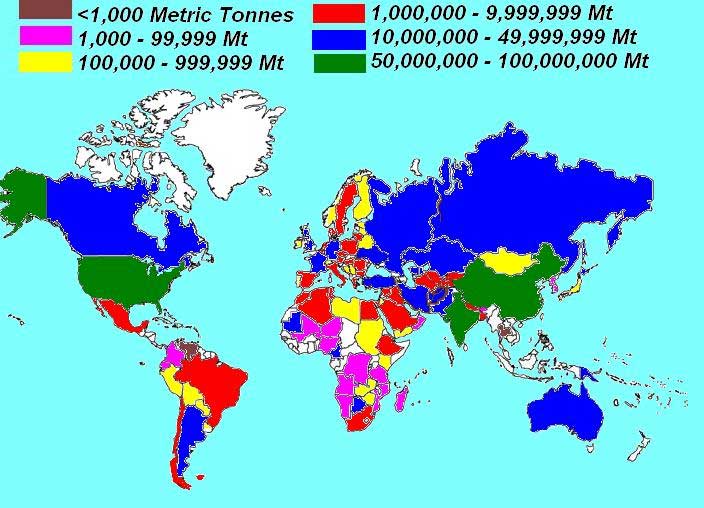
via archive.gramene.org
Future global wheat harvest is likely to be reduced by six per cent per each degree Celsius of local temperature increase if no adaptation takes place. Worldwide this would correspond to 42 million tons of yield reduction, which equals a quarter of current global wheat trade.
Wheat plays an important role in feeding the world, but climate change threatens its future harvest. Without adaptation, global aggregate wheat production is projected to decline on average by six per cent for each additional degree Celsius temperature increase. Worldwide this would correspond to 42 million tons yield reduction for one 1°C global warming.
This result has been generated by an international research consortium to which Natural Resources Institute Finland (previously known as MTT Agrifood Research Finland) substantially contributed. The results were published online in the high impact journal Nature Climate Change.
Losses expected throughout the world
The researchers found out that in response to global temperature increases, grain yield declines are predicted for most regions in the world. Considering present global production of 701 million tons of wheat in 2012, this means a possible reduction of 42 million tons per one degree Celsius of temperature increase.
– To put this in perspective, the amount is equal to a quarter of global wheat trade, which reached 147 million tons in 2013. In addition, wheat yield declines due to climate change are likely to be larger than previously thought and should be expected earlier, starting even with small increases in temperature.
– Therefore it is essential to understand how different climate factors interact and impact food production when reaching decisions on how to adapt to the effects of climate change, points out Prof. Dr. Reimund Rötter from Natural Resources Institute Finland.
Increased variability weakens stability in grain supply
In the study, the researchers systematically tested 30 different wheat crop models against field experiments in which growing season mean temperatures ranged from 15 °C to 26 °C. The temperature impact on yield decline varied widely across field test conditions. In addition, year-to-year variability increased at some locations because of greater yield reductions in warmer years and lesser reductions in cooler years.
– Increased yield variability is critical economically as it could weaken regional and global stability in wheat grain supply and food security, amplifying market and price fluctuations, as experienced during recent years, says Professor Rötter.
Read more: Global warming reduces wheat production markedly if no adaptation takes place
The Latest on: Wheat production
[google_news title=”” keyword=”Wheat production” num_posts=”10″ blurb_length=”0″ show_thumb=”left”]
via Google News
The Latest on: Wheat production
- Wheat price outlook hinges on Russiaon May 10, 2024 at 9:04 pm
The 2024-25 wheat market outlook hinges on one key question. "The bottom line is, it comes back to Russia. Are they going to be able to have a ...
- USDA anticipating rise in winter wheat cropon May 10, 2024 at 2:38 pm
The USDA sees a larger winter wheat crop in 2024. The projected crop of 1.278 billion bushels is 2% above 2023, following increased acreage totals, significantly improved crop weather in some key ...
- USDA sees larger new crop corn, soybean, wheat stockson May 10, 2024 at 2:21 pm
The USDA is projecting bigger new crop supplies for corn, soybeans, and wheat. New crop corn ending stocks are seen at 2.102 billion bushels, 80 million more than the current marketing year, with ...
- Wheat futures rise toward highest finish since Auguston May 10, 2024 at 12:18 pm
Wheat futures climbed Friday, with prices on track for their highest finish since August as cold weather looked to threaten production in Russia, which is among the world’s largest producers of the ...
- Wheat wins May 2024 WASDEon May 10, 2024 at 10:10 am
But for all the build-up surrounding today’s May 2024 WASDE, the markets initially yawned off USDA’s findings. U.S. supplies of corn, soybean, and wheat are expected to balloon in the upcoming ...
- USDA Projects Near-Record High for U.S. Soybean Productionon May 10, 2024 at 9:25 am
By Kirk Maltais U.S. farmers are expected to produce a near-record amount of soybeans in the upcoming growing season, the Department of Agriculture ...
- European Commodities: Wheat Continues Its Uptrend, But Could Be Ripe for a Pullbackon May 10, 2024 at 9:08 am
UK Feed Wheat (LWX24) has shown an impressive rise since March 11. The volatility is at its highest since November 2022, as the commodity keeps marking higher highs in the last 5 weeks. The 10-day ...
- Wheat Extends Pullback on Wednesdayon May 8, 2024 at 8:20 am
Tuesday afternoon, the Oklahoma Wheat Commission release the numbers from the annual wheat tour, with an average yield estimated at 33.68 bpa and production totaling 89.16 mbu. Last year’s final USDA ...
- High Plains Agriculture: How wheat breeding is helping local farmerson May 8, 2024 at 3:00 am
Wheat production in our region is challenged by diseases, insects, and our semi-arid climate. The Texas A&M AgriLife Wheat Breeding program in Bushland is ...
- Dry threatens Russian wheat productionon May 7, 2024 at 8:33 pm
Russia's wheat production faces threat amid weather propensity for a blocking high-pressure system as the El Niño influence subsides...Read More ...
via Bing News










